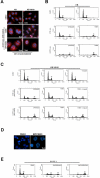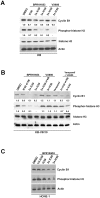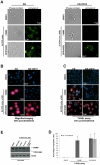BPR1K653, a novel Aurora kinase inhibitor, exhibits potent anti-proliferative activity in MDR1 (P-gp170)-mediated multidrug-resistant cancer cells
- PMID: 21887256
- PMCID: PMC3160846
- DOI: 10.1371/journal.pone.0023485
BPR1K653, a novel Aurora kinase inhibitor, exhibits potent anti-proliferative activity in MDR1 (P-gp170)-mediated multidrug-resistant cancer cells
Abstract
Background: Over-expression of Aurora kinases promotes the tumorigenesis of cells. The aim of this study was to determine the preclinical profile of a novel pan-Aurora kinase inhibitor, BPR1K653, as a candidate for anti-cancer therapy. Since expression of the drug efflux pump, MDR1, reduces the effectiveness of various chemotherapeutic compounds in human cancers, this study also aimed to determine whether the potency of BPR1K653 could be affected by the expression of MDR1 in cancer cells.
Principal findings: BPR1K653 specifically inhibited the activity of Aurora-A and Aurora-B kinase at low nano-molar concentrations in vitro. Anti-proliferative activity of BPR1K653 was evaluated in various human cancer cell lines. Results of the clonogenic assay showed that BPR1K653 was potent in targeting a variety of cancer cell lines regardless of the tissue origin, p53 status, or expression of MDR1. At the cellular level, BPR1K653 induced endo-replication and subsequent apoptosis in both MDR1-negative and MDR1-positive cancer cells. Importantly, it showed potent activity against the growth of xenograft tumors of the human cervical carcinoma KB and KB-derived MDR1-positive KB-VIN10 cells in nude mice. Finally, BPR1K653 also exhibited favorable pharmacokinetic properties in rats.
Conclusions and significance: BPR1K653 is a novel potent anti-cancer compound, and its potency is not affected by the expression of the multiple drug resistant protein, MDR1, in cancer cells. Therefore, BPR1K653 is a promising anti-cancer compound that has potential for the management of various malignancies, particularly for patients with MDR1-related drug resistance after prolonged chemotherapeutic treatments.
Conflict of interest statement
Figures






Similar articles
-
Design and synthesis of BPR1K653 derivatives targeting the back pocket of Aurora kinases for selective isoform inhibition.Eur J Med Chem. 2018 May 10;151:533-545. doi: 10.1016/j.ejmech.2018.03.064. Epub 2018 Apr 3. Eur J Med Chem. 2018. PMID: 29656197
-
Preclinical evaluation of AMG 900, a novel potent and highly selective pan-aurora kinase inhibitor with activity in taxane-resistant tumor cell lines.Cancer Res. 2010 Dec 1;70(23):9846-54. doi: 10.1158/0008-5472.CAN-10-3001. Epub 2010 Oct 8. Cancer Res. 2010. PMID: 20935223
-
Identification of genes that confer tumor cell resistance to the aurora B kinase inhibitor, AZD1152.Pharmacogenomics J. 2009 Apr;9(2):90-102. doi: 10.1038/tpj.2008.20. Epub 2009 Feb 3. Pharmacogenomics J. 2009. PMID: 19188929
-
Molecular targeting therapy of cancer: drug resistance, apoptosis and survival signal.Cancer Sci. 2003 Jan;94(1):15-21. doi: 10.1111/j.1349-7006.2003.tb01345.x. Cancer Sci. 2003. PMID: 12708468 Free PMC article. Review.
-
Update on aurora kinase inhibitors in gynecologic malignancies.Recent Pat Anticancer Drug Discov. 2008 Nov;3(3):162-77. doi: 10.2174/157489208786242322. Recent Pat Anticancer Drug Discov. 2008. PMID: 18991785 Free PMC article. Review.
Cited by
-
Functional impact of Aurora A-mediated phosphorylation of HP1γ at serine 83 during cell cycle progression.Epigenetics Chromatin. 2013 Jul 5;6(1):21. doi: 10.1186/1756-8935-6-21. Epigenetics Chromatin. 2013. PMID: 23829974 Free PMC article.
-
Discovery of BPR1K871, a quinazoline based, multi-kinase inhibitor for the treatment of AML and solid tumors: Rational design, synthesis, in vitro and in vivo evaluation.Oncotarget. 2016 Dec 27;7(52):86239-86256. doi: 10.18632/oncotarget.13369. Oncotarget. 2016. PMID: 27863392 Free PMC article.
-
Present Advances and Future Perspectives of Molecular Targeted Therapy for Osteosarcoma.Int J Mol Sci. 2016 Apr 6;17(4):506. doi: 10.3390/ijms17040506. Int J Mol Sci. 2016. PMID: 27058531 Free PMC article. Review.
-
Targeting AURKA in Cancer: molecular mechanisms and opportunities for Cancer therapy.Mol Cancer. 2021 Jan 15;20(1):15. doi: 10.1186/s12943-020-01305-3. Mol Cancer. 2021. PMID: 33451333 Free PMC article. Review.
-
Aurora Kinases as Therapeutic Targets in Head and Neck Cancer.Cancer J. 2022 Sep-Oct 01;28(5):387-400. doi: 10.1097/PPO.0000000000000614. Cancer J. 2022. PMID: 36165728 Free PMC article.
References
-
- Cheung CH, Coumar MS, Hsieh HP, Chang JY. Aurora kinase inhibitors in preclinical and clinical testing. Expert Opin Investig Drugs. 2009;18:379–398. - PubMed
-
- Cheung CH, Coumar MS, Chang JY, Hsieh HP. Aurora kinase inhibitor patents and agents in clinical testing: an update (2009–10) This article is an update to aurora kinase inhibitors review, which appeared in: Expert Opin. Ther. Patents 2009, 19, 1–36 and Expert Opin. Investig. Drugs 2009, 18, 1–20. Expert Opin Ther Pat. 2010;21:857–884. - PubMed
-
- Vischioni B, Oudejans JJ, Vos W, Rodriguez JA, Giaccone G. Frequent overexpression of aurora B kinase, a novel drug target, in non-small cell lung carcinoma patients. Mol Cancer Ther. 2006;5:2905–2913. - PubMed
Publication types
MeSH terms
Substances
LinkOut - more resources
Full Text Sources
Other Literature Sources
Research Materials
Miscellaneous

